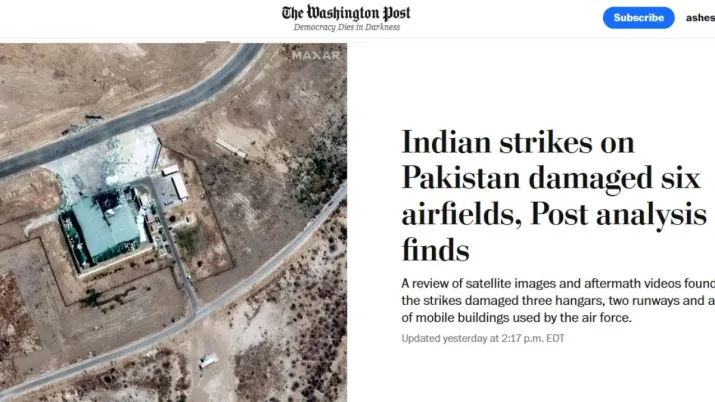Operation Sindoor was launched in response to the Pahalgam attack in which 25 tourists and a local guide were killed in cold blood by terrorists on April 22.
The Washington Post, in its analysis report, confirmed the success of India’s strikes on Pakistan, debunking Islamabad’s claims of ‘victory’. The report stated: “India’s strikes on Pakistan damaged runways and structures across at least six airfields.”
In retaliation for the terrorist attack in Jammu and Kashmir’s Pahalgam on April 22, the Indian Armed Forces launched Operation Sindoor on May 7 and targeted terror infrastructure in Pakistan and Pakistan-occupied Jammu and Kashmir, proved to be a resounding success. The scale of destruction India inflicted on terrorist camps and Pakistani airbases prompted acknowledgment from Western media outlets.
Earlier, the New York Times conceded that India had a “clear edge” in targeting Pakistan’s military facilities and airfields during the recent four-day confrontation, citing satellite images. Now, the Washington Post acknowledged that Indian strikes on Pakistan damaged runways and structures across “at least six airfields”. However, the Indian armed forces have said that 11 Pakistani airbases were struck during the counter-strike.
Washington Post analysis of Indian strikes on Pakistan
The Washington Post conducted a visual analysis of the Indian strikes on Pakistan, which quoted experts as saying that attacks were the “most significant attacks of their kind in decades of simmering conflict between the South Asian rivals”.
“The review of more than two dozen satellite images and aftermath videos found that the strikes heavily damaged three hangars, two runways, and a pair of mobile buildings used by the air force. Some of the sites hit by India were as deep as 100 miles inside the country,” the Washington Post report said.
The report also cited a senior lecturer in international relations at King’s College London, Walter Ladwig, saying “the strikes marked “the most extensive Indian air attacks on Pakistani military infrastructure since the 1971 war.”
According to the report, William Goodhind, a geospatial analyst at Contested Ground, a research project that uses satellite imagery to track armed conflict, said that India hit high-profile targets in precision strikes “with the aim of severely degrading Pakistan’s offensive and defensive air capabilities”.

Nur Khan air base was destroyed
At Nur Khan air base in Rawalpindi, just outside Islamabad, two mobile control centers were destroyed,” the report said.
According to experts, Pakistan’s Nur Khan airbase is one of the most important ones in the country as it is the military’s central transport hub, WP reported. This base is close to the Strategic Plans Division, the unit responsible for safeguarding the country’s nuclear warheads, which are stored in facilities across Pakistan.
The report also confirmed that Bholari and Shahbaz air bases in Pakistan suffered severe damage, with destruction of buildings used as aircraft hangars. “A large hole nearly 60 feet wide is visible in the roof of a hangar at Bholari, which experts said was consistent with a missile impact,” it said.
According to the military researcher, the Bholari hangar houses a Saab 2000 Airborne Early Warning and Control System aircraft — a surveillance plane worth tens of millions of dollars, The Washington Post reported.
Satellite imagery showed another large hole over 100 feet wide in a hangar at Shahbaz air base, which is used exclusively by the military and damage to a control tower. According to Goodhind, another hangar seemed to have been collapsed by a strike and an apparent radar site was destroyed at Sukkur Airport, which is used for civilian and military purposes.
Large craters in runways were left at Mushaf air base and Sheikh Zayed International Airport following India’s strikes. According to images from the satellite firms Planet and Maxar, the craters at Mushaf seemed to be fixed or under repair by the day after.
(With ANI inputs)
Also Read: India pushes for UN listing of LeT front TRF, delegation meets top counter-terror officials


